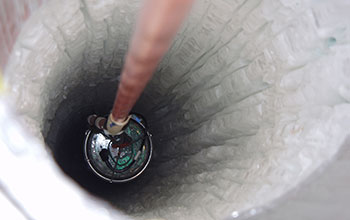Multimedia Gallery
Digital optical module lowered into hole at South Pole Station
A digital optical module is lowered into a hole in the ice at Amundsen-Scott South Pole Station as part of the IceCube project.
More about this image
IceCube will search for neutrinos from distant astrophysical sources in a quest to answer questions about the origins of the universe. While trillions of neutrinos pass through Earth every second, they are difficult to detect. IceCube will use Earth as a filter, looking through the planet to the Northern Hemispheric skies. Eighty holes will be drilled into the ice with each hole 2.4 km deep. Sixty digital optical modules (DOMs) will be lowered into each hole and frozen into place. When neutrinos pass through ultra-clear blue ice, the collision produces a particle -- called a muon -- that radiates blue light. The DOMs will detect this light and send back data, via the internet, to scientists around the world.
You can learn more about IceCube Here. [Note: Please see special restrictions regarding use of this image, below.] (Date image taken: December 2005; date originally posted to NSF Multimedia Gallery: March 3, 2017)
Credit: Ethan Dicks
See other images like this on your iPhone or iPad download NSF Science Zone on the Apple App Store.
Special Restrictions: Note: Any commercial use of this image requires the photographer's permission.
Images and other media in the National Science Foundation Multimedia Gallery are available for use in print and electronic material by NSF employees, members of the media, university staff, teachers and the general public. All media in the gallery are intended for personal, educational and nonprofit/non-commercial use only.
Images credited to the National Science Foundation, a federal agency, are in the public domain. The images were created by employees of the United States Government as part of their official duties or prepared by contractors as "works for hire" for NSF. You may freely use NSF-credited images and, at your discretion, credit NSF with a "Courtesy: National Science Foundation" notation.
Additional information about general usage can be found in Conditions.
Also Available:
Download the high-resolution JPG version of the image. (1.4 MB)
Use your mouse to right-click (Mac users may need to Ctrl-click) the link above and choose the option that will save the file or target to your computer.



